Learn
Shots Heard Round the World
Preparing for a Fight
After the Boston Tea Party, hostility grew between the American colonies and Great Britain, and colonists were upset by unfair taxation, a lack of representation in Parliament, and restriction of freedoms. Britain tried to maintain control by passing the Coercive Acts which the colonists called the Intolerable Acts , which ignited the colonists' passion to protect their rights and ended with trade boycotts of British goods. King George III ordered troops to squash the rebellious American Patriot insurgence at once and maintain order.
The First Continental Congress ended on October 26, 1774 and vowed to meet again in the spring. On November 18, King George III responded to the colonists' plea for help by writing, "The New England colonies are in a state of rebellion, blows must decide."
Patriots Prepare
Patriots were American colonists considered "rebels" by King George III who were prepared to fight for their rights and independence from Great Britain. They followed the advice of the First Continental Congress to prepare in case of war with Great Britain.
Militias were armies composed of citizens to be used in an emergency. They were not made of professional soldiers. Militias were formed and began to stockpile weapons, storing them in a town about twenty-miles outside of Boston called Concord.
Patriots who joined these militias were called minutemen because they trained and prepared themselves to be ready to fight on a minute's notice.
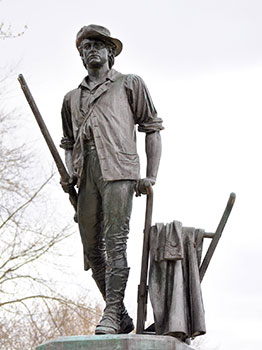
Patrick Henry
Just a few days before the first fighting took place, Patrick Henry warned his fellow Virginians to prepare for a coming war:
"Gentlemen may cry, 'Peace! Peace!' — but there is no peace .... The next gale that sweeps from the north will bring to our ears the clash of resounding arms!
"Is life so dear, or peace so sweet, as to be purchased at the price of chains and slavery? Forbid it, Almighty God! I know not what course others may take; but as for me, give me liberty or give me death!"

The British Are Coming...
On April 18, 1775, approximately 700 British soldiers marched out of Boston in a secret plan to seize the weapons and supplies at Concord. Patriots learned about the plan and sent Paul Revere, Dr. Samuel Prescott, and William Dawes to warn other Patriot leaders across the countryside about the news that the "British are coming".
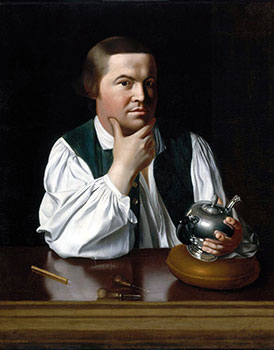
Paul Revere's famous "midnight ride" ended when he was captured by the British, but not before he arrived in Lexington around midnight to warn Samuel Adams and John Hancock about the British plan.
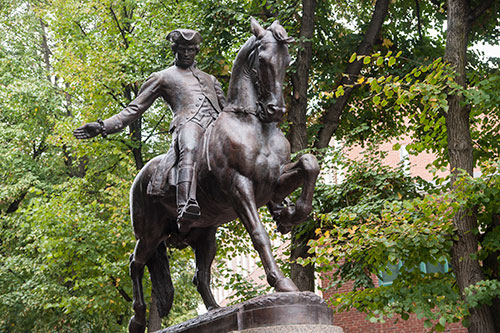
"Shot Heard Round the World"
British troops were deployed to Concord to confiscate weaponry and capture Patriot leaders. In route to Concord, on the morning of April 19, 1775, the "shot heard round the world" was fired at Lexington and the American Revolution began.
The shots fired at Lexington in 1775 were much more than just the first skirmish of the Revolutionary War. These shots were the beginning of an extraordinary event, the American Revolution. The Revolution was more than just a war fought on the battlefields. It was a revolution of ideas based on freedom, liberty, and democracy that would spread throughout the world influencing other revolutions like the French Revolution!
The Battles of Lexington and Concord are usually viewed as a collective battle because they occurred on the same day, April 19, 1775, and were within close proximity to each other. Lexington and Concord marked the first military action of the Revolutionary War.
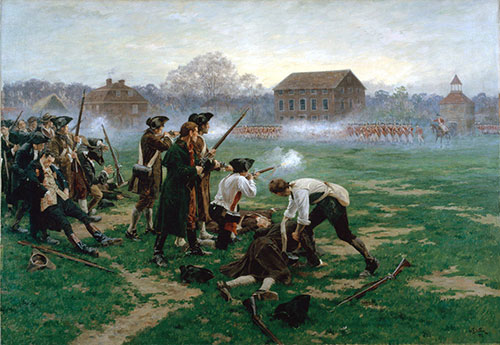
The minutemen at Lexington would try to stall the British forces to give their fellow patriots at Concord time to disperse the stockpiled weapons before the British arrived on April 19, 1775.
About 70 armed minutemen were waiting on the British as they arrived in Lexington at dawn. The British commanded the militia, "Throw down your arms and you shall come to no harm."
Before the militia could respond, someone fired a shot. No one knows who fired the first "shot heard round the world" at Lexington.
British troops began firing and, within a few minutes, eight Americans were dead and ten more were wounded.
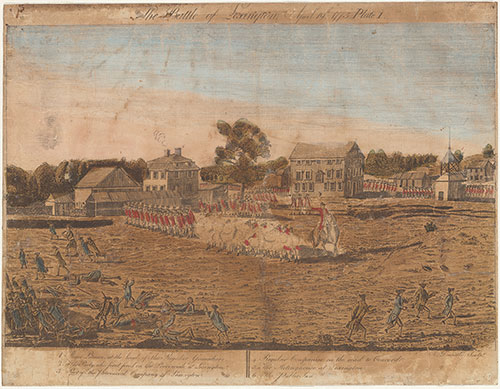
The British then marched five miles to Concord and burned the remainder of the militia's weapons before returning to Boston. The British entered the town of Concord without opposition and began destroying American military supplies.

An American militia force of 300 men tried to re-enter the town by crossing the North Bridge, but the British forces guarding it fired on them and killed two more Americans.

The American militia employed guerrilla warfare, a tactic using small surprises and knowledge of the terrain to hide their movements. Thanks to these tactics and the traditional straight-line ranks of the British Redcoats, by the time they returned to Boston, more than 270 Redcoats were wounded, missing, or dead.
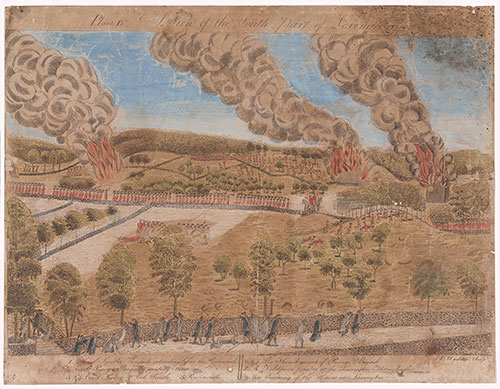
Second Continental Congress
The Second Continental Congress met in May 1775, less than a month after Lexington and Concord, in order to:
- Deal with the military crisis,
- Form a continental army, and
- Choose a Commander-in-Chief for the army, General George Washington.
King George III had already refused to look at the Olive Branch Petition (sent by the Continental Congress to profess loyalty to the British crown and plead with the king to reach a compromise) before fighting broke out. He affirmed that the colonies were in an open state of rebellion.
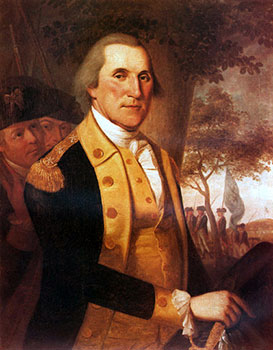
British Strengths and Weaknesses
The British were a world power with a strong government and plenty of financial resources. They had a well-trained and well-equipped army and the most powerful navy in the world.
They also hired mercenaries, or foreign soldiers who were paid to fight. About 30,000 German soldiers were hired by the British to help fight. Because they were mainly from the German state of Hesse-Cassel, they were referred to as Hessians. While these paid soldiers did increase British military numbers, they were fighting without a real cause.
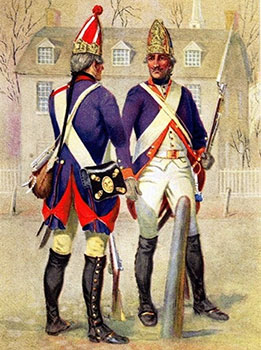
In addition, there was not a lot of support for the war in England due to the high costs of the war.
Finally, fighting in a foreign country meant getting supplies and support across the Atlantic Ocean, which was challenging and costly.
American Strengths and Weaknesses
The patriots had "home field advantage", as they were fighting for the great cause of liberty in their own backyards. The generals used their knowledge of the area and espionage spying to make good military decisions.
Eventually, Americans got additional support from the French and financial support from Spain.
On the other hand, Americans had an untrained and unstable militia.
Congress argued over support for the army and therefore, the American forces were often short on ammunition during the Battle of Bunker Hill and food and supplies at Valley Forge .
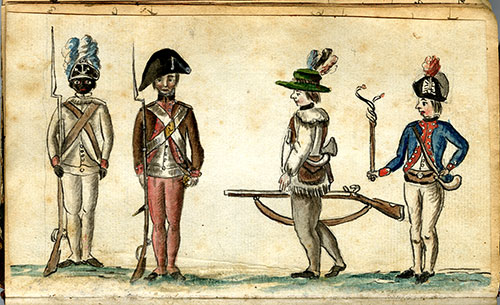
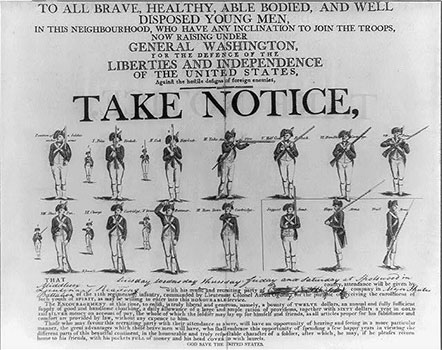
Comparison Chart
| British Strengths | American Strengths |
|---|---|
|
|
| British Weaknesses | American Weaknesses |
|---|---|
|
|
Additional Resources
Read Lexington and Concord, if you would like to know more about the first shots fired!
Explore American Revolution: People, if you would like to know more about the Patriots of the Revolutionary War.